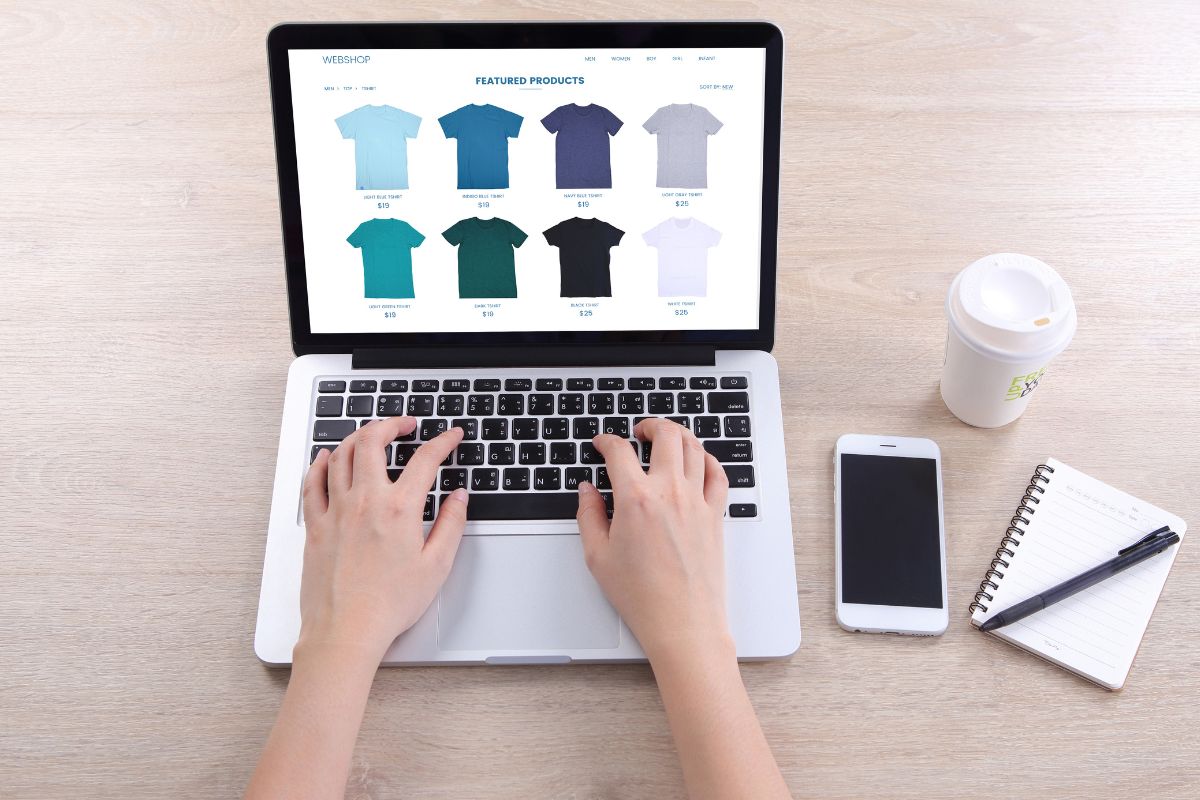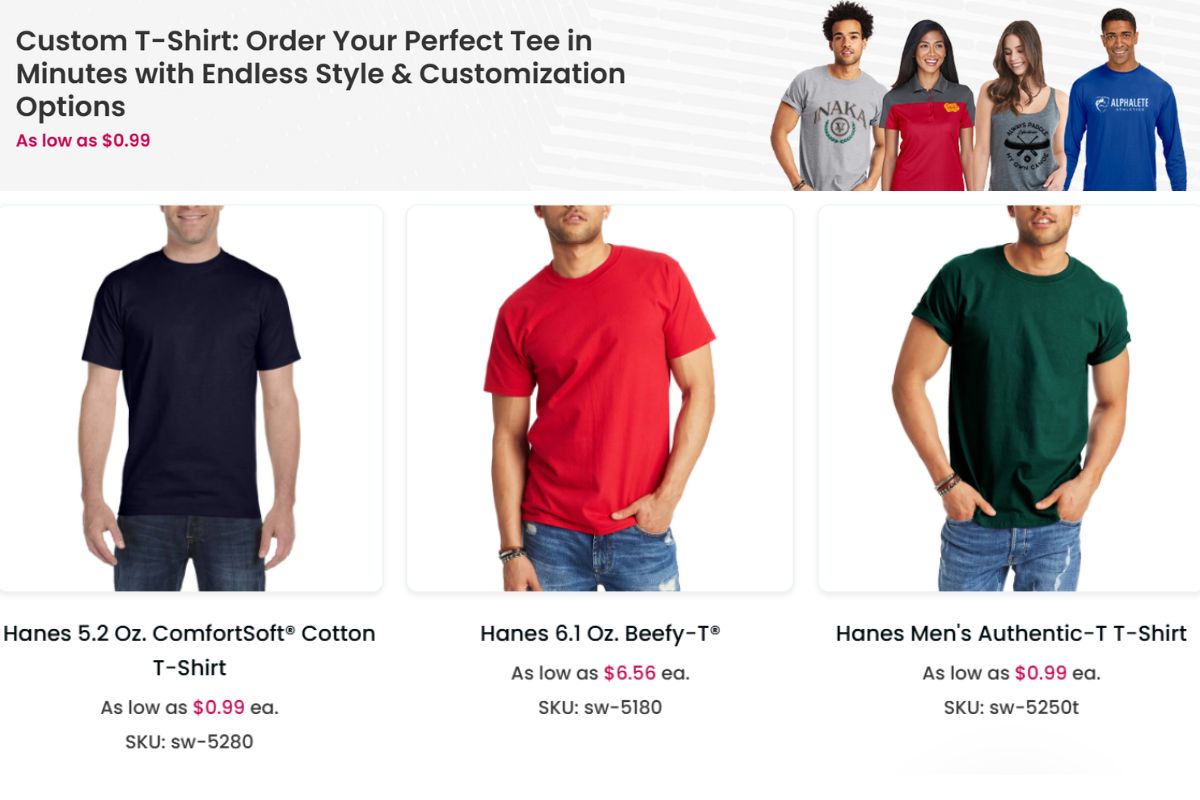T-shirt marketing is a powerful way to grow your t-shirt business in today’s vibrant industry. With creativity at the forefront, you can turn simple designs into captivating campaigns that engage customers and boost sales.
To succeed, you must combine a solid marketing strategy with high-quality products that people love to wear. Utilizing social media platforms is essential for reaching your target audience.
From Facebook to Instagram, these channels offer unique opportunities for visibility and direct interaction with potential buyers.
Table of contents
- Understanding the T-Shirt Market
- Setting Up a T-Shirt Business
- Designing Your T-Shirts
- Producing Your T-Shirts
- Building an Online Presence
- Marketing Your T-Shirts
- Sales and Distribution
- Promotion Tactics
- Maximizing Brand Impact
- Analyzing Performance
- Final Considerations
- Frequently Asked Questions
- What strategies can I use to market my t-shirt business on social media?
- How do I craft effective advertising slogans for my t-shirt brand?
- What components should be included in a t-shirt marketing plan?
- What are some successful t-shirt marketing campaigns or examples?
- How can I increase online sales for my t-shirt business?
- What are the best companies or services that specialize in t-shirt marketing?
Engaging content, influencer collaborations, and shoppable posts can draw customers to your brand and keep them coming back for more.
As the t-shirt industry continues to expand, finding your niche and crafting a compelling brand identity becomes crucial.
By focusing on what makes your designs unique and connecting with your customers, you can establish a loyal following that elevates your business.
Understanding the T-Shirt Market
The t-shirt market is dynamic and offers numerous opportunities for success. To navigate this landscape, it’s important to grasp the industry overview and current trends along with the demographics of potential customers.
Industry Overview
The t-shirt industry is valued as a multi-billion dollar market. In 2024, China leads in revenue generation, making up about $5.92 billion of the global market.
Key factors affecting this industry include:
- Customization: Many consumers seek personalized designs for specific events.
- E-commerce Growth: Online platforms make it easier for sellers to reach customers directly.
- Branding Opportunities: Businesses often use t-shirts for promotional events, enhancing brand visibility.
Market research shows that understanding consumer preferences is essential. Businesses that adapt to trends can capture a larger share of the market.
Current Trends and Demographics
Social media is a powerful tool in reaching your target audience. Many potential customers spend significant time on platforms like Facebook, Instagram, and TikTok.
Demographics to consider include:
- Age Group: Young adults aged 18-34 are major buyers.
- Interests: Fashion trends, pop culture, and social causes drive demand.
- Geographic Regions: Urban areas often show higher sales due to fashion consciousness.
Industry trends show an increase in demand for environmentally friendly and ethically produced shirts. As consumers become more aware, they lean towards brands that align with their values.
Setting Up a T-Shirt Business
| Marketing Idea | Description | Why It Works |
|---|---|---|
| Social Media Advertising | Run targeted ads on Facebook, Instagram, and TikTok. | Reaches a broad audience and allows precise targeting based on interests. |
| Influencer Collaborations | Partner with influencers or micro-influencers. | Builds trust and expands reach within niche markets. |
| SEO-Optimized Website | Optimize product listings and blogs with keywords. | Improves visibility on search engines and drives organic traffic. |
| Limited Edition Drops | Create scarcity with time-sensitive or exclusive designs. | Encourages urgency and increases demand. |
| Email Marketing Campaigns | Send personalized offers, newsletters, and abandoned cart reminders. | Maintains customer engagement and boosts repeat sales. |
| Customizable T-Shirts | Allow customers to design or personalize their tees. | Increases customer satisfaction and encourages word-of-mouth promotion. |
| TikTok & Reels Challenges | Launch a challenge with branded hashtags. | Increases engagement and creates viral potential. |
| Print-on-Demand Partnerships | Sell through platforms like Printful, Teespring, or Redbubble. | Reduces upfront costs and simplifies fulfillment. |
| Affiliate Marketing Program | Offer commissions to bloggers or content creators. | Expands reach without high upfront marketing costs. |
| Pop-Up Shops & Events | Sell at local markets, festivals, or collaborations with stores. | Creates a hands-on shopping experience and builds brand awareness. |
Starting a t-shirt business requires careful planning and a clear understanding of your target audience.
It’s important to define your niche and create a strong brand identity to stand out in a competitive market.
Business Plan Essentials
Creating a business plan is vital for your t-shirt business. This document should outline your goals, target market, and sales strategies.
Key components to include:
- Executive Summary: A brief overview of your business.
- Market Analysis: Research your competition and identify your niche audience.
- Budgeting: Estimate costs for materials, production, and marketing.
- Sales Strategy: Decide on pricing and distribution methods.
A clear business plan helps you stay focused and guides your decisions as your business grows.
Choosing Your Niche
Defining your niche is crucial for attracting the right customers. Think about what makes your t-shirt designs unique.
Consider these factors:
- Interests: Focus on themes that you are passionate about.
- Trends: Research current fashion and cultural trends.
- Demographics: Identify your target market’s age, gender, and lifestyle.
By narrowing your focus, you can better connect with your audience and tailor your designs to meet their preferences.
Building Your Brand Identity
A strong brand identity sets you apart from competitors. It reflects your business’s values and connects you with customers.
Elements to develop include:
- Company Name: Choose a memorable and relevant name.
- Logo: Design a logo that captures your brand’s essence.
- Color Scheme and Fonts: Pick colors and fonts that resonate with your target audience.
Consistent branding across your online presence will help create trust and recognition. Use your branding in all marketing materials and social media to build loyalty.
Designing Your T-Shirts
Creating compelling designs is essential to your t-shirt marketing success. Your designs should stand out while also representing your brand. This section covers the key aspects of designing your t-shirts, including how to craft unique designs, use design tools, and ensure product quality.
Crafting Unique Designs
To grab attention, your designs need to be unique. Start by brainstorming ideas that reflect your brand’s identity. Consider your target audience and what resonates with them.
You can use themes, colors, and styles that connect with their interests.
Tips for Unique Designs:
- Use bold colors to attract attention.
- Experiment with different styles like minimalism, vintage, or graphic art.
- Incorporate meaningful symbols or messages.
Researching trends can also inspire your designs. Monitor what’s popular in fashion or social media to stay relevant. Remember, your t-shirts should tell a story that engages customers emotionally.
Leveraging Design Tools
Using design tools can simplify the creation process. Canva and Placeit are excellent resources for designing eye-catching t-shirts. These platforms offer templates that can help you start with a professional look.
Advantages of Using Design Tools:
- Easy to Use: Drag and drop features make designing simple, even for beginners.
- Variety of Templates: Access a wide range of design templates tailored for t-shirts.
- Customization: Adjust colors, fonts, and images to match your vision.
After designing, you can preview how your shirts will look before printing. This can save you time and resources while ensuring your final product meets your standards.
The Importance of Quality
Quality is crucial in t-shirt design. A great design is wasted on a poorly made shirt.
Choose comfortable materials that fit well and look good on various body types. This ensures your customers will be happy and likely to return.
Key Aspects of Quality:
- Fabric Options: Consider cotton, polyester, or blends that suit your audience.
- Print Method: Choose high-quality printing techniques like screen printing or DTG (Direct to Garment) for durability.
- Attention to Detail: Check for clarity in designs and ensure that any text is readable from a distance.
When customers wear your shirts, their satisfaction leads to word-of-mouth marketing, boosting your brand’s visibility. Prioritizing quality will enhance your overall t-shirt marketing strategy.
Producing Your T-Shirts
| Production Method | Description | Best For | Pros | Cons |
|---|---|---|---|---|
| Screen Printing | Uses stencils and ink pressed through a mesh screen onto fabric. | Bulk orders, simple designs with few colors. | Cost-effective for large orders, durable prints. | High setup cost, not ideal for detailed/multi-color designs. |
| Direct-to-Garment (DTG) | Inkjet printer applies ink directly to fabric. | Small orders, detailed and multi-color designs. | No setup costs, high detail, unlimited colors. | Expensive per unit, works best on cotton. |
| Heat Transfer Printing | Design is printed on transfer paper and pressed onto fabric using heat. | Custom one-off prints, small batches. | Vibrant colors, easy for customization. | Less durable, can peel over time. |
| Sublimation Printing | Heat transfers ink into fabric, bonding permanently. | Polyester fabrics, all-over prints. | Long-lasting, does not fade or crack. | Only works on polyester, requires special ink and paper. |
| Vinyl Cutting | Designs are cut from colored vinyl and heat-pressed onto fabric. | Simple graphics, names/numbers (sportswear). | Durable, great for small orders. | Limited colors per design, not ideal for large graphics. |
| Embroidery | Stitching designs into fabric using thread. | Premium branding, corporate wear. | High-end look, durable. | Expensive, limited design flexibility. |
Creating your T-shirts involves several important processes that can help you deliver quality products to your customers. You should consider printing techniques, using print-on-demand services, and effectively managing bulk orders.
Screen Printing Techniques
Screen printing is a popular method for producing T-shirts. This technique involves creating a stencil, called a screen, for each color in your design. Here’s how it works:
- Preparation: Start by choosing your design and colors. You’ll need a separate screen for each color.
- Setup: Place the screen on the shirt and apply ink. A squeegee is used to push ink through the screen onto the fabric.
- Drying: After printing, shirts must dry to set the ink. This can be done using a dryer or air drying.
Screen printing is ideal for large orders because it lowers the cost per shirt. However, it requires more time to set up for smaller runs.
Print on Demand Services
Print-on-demand (POD) services allow you to create and sell T-shirts without holding inventory. Here’s how POD typically works:
- Design Upload: You upload your designs to a POD platform.
- Set Your Price: You decide on a selling price, considering production costs.
- Customer Orders: When someone orders your T-shirt, the POD service prints and ships it directly to the customer.
This method reduces risk since you only pay for shirts that sell. It’s great for testing new designs without a significant upfront investment, but be mindful of longer shipping times.
Managing Bulk Orders
Handling bulk orders can be challenging but rewarding. Here are key steps to manage them effectively:
- Supplier Relationships: Establish strong connections with suppliers for better negotiation on prices and turnaround times.
- Order Tracking: Use tools to track inventory and orders. This helps prevent overselling and running out of stock.
- Quality Control: Inspect bulk orders upon arrival to ensure the shirts meet your standards.
By managing bulk orders well, you can meet customer demand while maximizing profits. It’s crucial to plan ahead to avoid delays in delivery.
Building an Online Presence

Creating a strong online presence is essential for your t-shirt business. Focus on setting up an effective online store, optimizing for eCommerce, and leveraging social media to reach your target audience.
Creating Your Online Store
To start, choose an eCommerce platform like Shopify, WooCommerce, or BigCommerce. These platforms offer user-friendly templates and tools.
- Design: Make your store visually appealing. Use high-quality images and consistent branding.
- Product Listings: Write clear descriptions for each t-shirt. Include sizing information and care instructions.
- Checkout Process: Simplify the checkout to reduce cart abandonment. Offer multiple payment options for convenience.
Make sure your store is mobile-friendly since many customers shop on their phones.
Optimizing for Ecommerce
Search Engine Optimization (SEO) is key to driving traffic to your online store. Work on the following:
- Keywords: Use relevant keywords in your product titles and descriptions.
- Meta Tags: Write clear meta descriptions to improve visibility in search results.
- Page Speed: Ensure your website loads quickly to keep visitors engaged.
Regularly update your content with new products or blog posts. This can help improve your search rankings and attract more customers.
Utilizing Social Media
Social media can be a powerful tool for marketing your t-shirt business. Focus on platforms like Instagram, Facebook, and Pinterest.
- Content Creation: Share engaging content that showcases your t-shirts. Use images, videos, and stories to attract attention.
- Target Audience: Identify your audience and tailor your content to their interests.
- Interaction: Encourage user engagement through contests, polls, and comments. Respond to inquiries promptly.
Using targeted ads on these platforms can expand your reach. Pay attention to analytics to see what type of content resonates best with your followers.
Marketing Your T-Shirts

To succeed in t-shirt marketing, it’s essential to create a solid marketing strategy that aligns with your business goals. This involves developing a clear marketing plan and effectively executing marketing campaigns. Each step plays a key role in boosting your sales and reaching your target audience.
Developing a Marketing Strategy
Start by identifying your target audience. Knowing who will wear your t-shirts helps shape your marketing messages. Consider factors such as age, interests, and location.
Next, analyze your competitors. Look at their designs, pricing, and marketing techniques. This insight will help you find ways to differentiate your t-shirts.
Finally, set measurable objectives. Decide what you want to achieve, like a specific number of sales or website visits. Having clear goals keeps your efforts focused and allows you to track your success.
Crafting a Marketing Plan
Creating a detailed marketing plan is crucial. Begin by outlining your t-shirt designs and how they relate to your brand. This will help in forming a strong brand identity.
Determine the marketing channels you’ll use. Social media platforms like Instagram and Facebook allow for direct interaction with potential customers. Consider local events where you can promote your t-shirts directly to your community.
Also, plan your budget. Allocate funds for advertising, promotions, and collaborations with influencers. Tracking your spending ensures you stay within budget and maximize your resources.
Executing Marketing Campaigns
Running a t-shirt marketing campaign involves putting your plan into action.
Start with social media campaigns. Use eye-catching images of your t-shirts to grab attention.
Engage with your audience through contests or giveaways. This creates buzz and encourages sharing.
Collaborate with local influencers to reach a broader audience. Their followers may be interested in your designs.
Don’t forget to measure your campaign results. Use analytics tools to see what worked and what didn’t.
Adjust future campaigns based on this data to improve your effectiveness.
Sales and Distribution
| Strategy | Description | Best For | Pros | Cons |
|---|---|---|---|---|
| E-commerce Store | Selling via platforms like Shopify, WooCommerce, or BigCommerce. | Brands looking for full control over their store. | High profit margins, brand control. | Requires marketing investment, website management. |
| Marketplaces (Amazon, eBay, Etsy) | Listing products on existing marketplaces with high traffic. | Sellers looking for built-in audience reach. | Easy setup, access to global customers. | High competition, platform fees. |
| Print-on-Demand (POD) Services | Using providers like Printful, Printify, or Redbubble to fulfill orders. | Low-budget startups, test-run businesses. | No inventory cost, easy scaling. | Lower profit margins, dependency on third-party fulfillment. |
| Social Media Selling (Facebook, Instagram, TikTok) | Using social commerce features to sell directly via social media. | Trend-based designs, influencer-driven sales. | Direct audience engagement, viral potential. | Algorithm-dependent, requires active content creation. |
| Wholesale Distribution | Selling in bulk to retailers, boutiques, or online stores. | Mass production brands, B2B sales. | High-volume sales, stable income. | Lower profit per unit, requires bulk production. |
| Pop-up Shops & Events | Selling t-shirts at fairs, markets, and special events. | Brands focusing on local or niche markets. | Face-to-face customer interaction, brand exposure. | Seasonal or location-dependent, upfront investment. |
| Subscription Boxes | Offering t-shirts through monthly subscriptions. | Fans of unique or exclusive designs. | Recurring revenue, customer retention. | High acquisition cost, requires fresh designs. |
| Corporate & Custom Orders | Selling customized t-shirts to businesses, teams, or events. | Promotional merchandise, corporate gifting. | Large bulk orders, steady clients. | Custom designs can limit scalability. |
Effective sales and distribution strategies are crucial for your t-shirt business. They help you reach more customers and ensure satisfaction.
Understanding your sales channels and providing good customer service will support your growth.
Understanding Sales Channels
You have several sales channels to choose from when selling t-shirts.
Common options include online marketplaces, your own e-commerce website, and social media platforms. Each channel has its own advantages.
Online Marketplaces: Platforms like Amazon and Etsy can help you reach a larger audience quickly.
E-commerce Website: Creating a personal website allows for greater brand control and customization.
Social Media: Utilizing sites like Facebook and Instagram can directly engage your audience and boost sales.
Identify which channels align best with your target audience. Tailor your marketing strategy to fit the strengths of each channel for maximum effectiveness.
Fulfillment and Customer Service
Fulfillment and customer service are vital for keeping customers happy.
Efficient order processing and shipping will enhance buying experiences.
Order Fulfillment: Choosing a reliable fulfillment partner can streamline the shipping process. Quick delivery times can encourage repeat business.
Customer Service: Providing excellent support is key. Respond promptly to inquiries and resolve issues quickly.
Consider using tools like live chat options and clear return policies. This helps build customer trust and loyalty.
By focusing on these areas, you will create a positive shopping experience that boosts sales.
Promotion Tactics

Effective promotion tactics are essential for maximizing your t-shirt sales. You can use a mix of email marketing, user-generated content, and collaborations with brand ambassadors to reach more customers.
Email Marketing and Discounts
Email marketing is a direct way to connect with your customers.
Start by building a mailing list of people who are interested in your t-shirts. Offer exclusive discounts or early access to new designs to encourage sign-ups.
Tips for successful email marketing:
- Personalization: Use customer names to make emails feel more personal.
- Clear Titles: Create eye-catching subject lines to increase open rates.
- Call to Action: Include clear buttons or links for customers to shop.
Sending regular newsletters with updates and special offers can keep your audience engaged.
You can also use holidays or events as reasons to send limited-time discounts.
Leveraging User-Generated Content
User-generated content (UGC) is a powerful promotional tool.
Encourage your customers to share photos of themselves wearing your t-shirts on social media. This not only builds community but also acts as authentic advertising.
Consider creating a unique hashtag for your brand. This makes it easy to find and share customer images. Highlighting these photos on your website or social media can create a sense of connection.
Benefits of UGC:
- Trust: Real customers build trust with potential buyers.
- Engagement: Sharing customer photos encourages more people to post their own.
- Cost-Effective: This form of marketing requires little investment.
Collaborating with Brand Ambassadors
Brand ambassadors are individuals who promote your t-shirts to their followers.
Look for influencers or satisfied customers who align with your brand values. They can create awareness and drive sales.
Offer them free products in exchange for reviews or shoutouts on their platforms. This partnership can expand your reach significantly.
Key factors for successful collaborations:
- Authenticity: Choose ambassadors who genuinely appreciate your products.
- Clear Expectations: Communicate what you expect in terms of posts and engagement.
- Tracking Results: Use unique promo codes to measure sales generated by each ambassador.
These tactics can enhance your marketing efforts and help you connect with your audience on multiple levels.
Maximizing Brand Impact
| Strategy | Description | Benefits |
|---|---|---|
| Strong Visual Identity | Create a unique logo, color scheme, and brand style guide. | Increases brand recognition and recall. |
| Consistent Messaging | Maintain a uniform tone and message across all platforms. | Builds trust and a loyal customer base. |
| Influencer & Affiliate Marketing | Partner with influencers to reach targeted audiences. | Expands brand reach with authentic endorsements. |
| Content Marketing | Publish blogs, videos, and guides to engage and educate customers. | Establishes brand authority and drives organic traffic. |
| Social Media Engagement | Actively interact with followers and run community-driven campaigns. | Strengthens brand loyalty and creates word-of-mouth marketing. |
| Customer-Centric Approach | Personalize communication and offer excellent support. | Enhances customer satisfaction and retention. |
| Sustainability & Ethical Practices | Showcase eco-friendly or ethical initiatives in business. | Appeals to conscious consumers and boosts reputation. |
| Experiential Marketing | Host events, pop-ups, or interactive campaigns. | Creates memorable brand experiences and deeper connections. |
| Email & SMS Marketing | Utilize automation and segmentation for personalized outreach. | Drives conversions and improves customer engagement. |
| Strategic Partnerships & Collaborations | Work with complementary brands to expand audience reach. | Creates synergy and enhances brand credibility. |
To effectively maximize your brand’s impact through t-shirt marketing, focus on building brand loyalty and creating emotional connections with your audience. Both strategies help in enhancing brand awareness and encouraging lasting customer relationships.
Establishing Brand Loyalty
Creating a strong brand loyalty is essential for long-term success. When you offer custom t-shirts, you give your customers a way to showcase their support for your brand.
Consider these tactics:
- Quality Designs: Use appealing graphics and slogans that resonate with your audience.
- Rewards Programs: Encourage repeat purchases by offering discounts or freebies on branded apparel.
When customers wear your t-shirts, they become walking advertisements, increasing your brand visibility.
Each time someone sees your logo or slogan, it reinforces familiarity, leading to trust. This connection encourages them to choose your brand over competitors, ultimately driving customer loyalty.
Creating Emotional Connections
Emotional connections can significantly enhance your brand’s impact. When customers feel connected to your brand, they are likely to share their experiences with others.
To create these connections:
- Share Your Story: Use the t-shirt as a canvas to express your brand’s mission or values.
- Community Initiatives: Participate in local events or causes and provide t-shirts to promote this involvement.
When customers associate positive feelings with your brand, they become advocates.
Wearing your t-shirt can evoke memories of events or experiences that tie back to your brand, making them feel a part of something bigger. This strengthens the bond and encourages customers to promote your brand both online and offline.
Analyzing Performance

To ensure your T-shirt marketing efforts are successful, it’s crucial to analyze performance. By measuring your campaigns and adjusting strategies based on analytics, you can maximize your impact.
Measuring Campaign Success
Start by setting clear goals for your T-shirt marketing campaign. This could include targets for sales, website traffic, or social media engagement.
Key Performance Indicators (KPIs) to monitor might include:
- Sales Volume: Track how many T-shirts you sell during a specific period.
- Conversion Rates: Measure the percentage of visitors who make a purchase.
- Cost Per Acquisition (CPA): Calculate how much you spend to gain each customer.
Using tools like Google Analytics allows you to gather data about user behavior. Look for trends in customer engagement and preferences.
Pay attention to feedback on social media and customer reviews. This data is vital for understanding what works and what doesn’t.
Adjusting Strategies Based on Analytics
With performance data in hand, it’s time to refine your marketing strategies.
Analyze which platforms bring the most traffic and conversions. Focus your efforts on those channels.
For instance, if Instagram and Facebook yield better results, allocate more resources there.
Use Google Trends to identify popular keywords and topics within your niche. Adjust your promotional content accordingly.
Consider seasonal trends and holidays for targeted campaigns. Also, keep an eye on competitor strategies to find new ideas.
Regular review cycles are important. Monthly or quarterly assessments can keep your campaign aligned with your goals.
Based on your findings, modify your advertising approaches, target audience, or even your T-shirt designs. This continuous improvement will enhance your marketing effectiveness.
Final Considerations
As you develop your t-shirt marketing strategy, it’s essential to focus on budgeting and selecting the right printing partners. These elements can greatly affect the success of your business.
Budgeting for Marketing
Creating a marketing budget is vital for your t-shirt business.
Start by listing all potential expenses related to marketing campaigns. This can include:
- Social Media Advertising: Allocate funds for platforms like Facebook and Instagram.
- Influencer Collaborations: Consider costs for partnering with local influencers.
- Promotional Materials: Budget for any printed materials, like flyers or business cards.
You should aim to allocate about 10-20% of your projected revenue to your marketing budget.
Track your spending and adjust as needed. This way, you can ensure that you are investing wisely to maximize your return.
Choosing Printing Partners
Selecting a good printing partner is crucial to ensure quality products.
Start by researching several options and compare their offerings. Look for:
- Quality of Prints: Request samples to evaluate print quality and fabric.
- Turnaround Time: Confirm how quickly they can fulfill orders.
- Pricing: Compare quotes while factoring in the quality of service.
Your printing partner should also align with your business values. A reliable partner can help you meet customer expectations and maintain your brand’s reputation. Make sure to establish clear communication to facilitate a smooth workflow.
Frequently Asked Questions
In this section, you will find answers to common questions about t-shirt marketing. These details can help you improve your marketing efforts and boost your sales.
What strategies can I use to market my t-shirt business on social media?
To market your t-shirt business on social media, use platforms like Instagram, Facebook, and TikTok.
Share high-quality images of your designs and engage with followers through stories and live sessions. Collaborate with influencers to reach a wider audience.
How do I craft effective advertising slogans for my t-shirt brand?
Create slogans that reflect your brand’s identity and connect with your target audience.
Focus on short, catchy phrases that are easy to remember. Incorporate humor or emotional appeal to make your slogan impactful.
What components should be included in a t-shirt marketing plan?
A t-shirt marketing plan should include a clear target audience, marketing goals, and pricing strategy.
It should also cover promotional tactics like social media campaigns, email marketing, and partnerships. Finally, include a budget for advertising and production costs.
What are some successful t-shirt marketing campaigns or examples?
Successful t-shirt campaigns often leverage trends or social movements.
For example, t-shirts supporting causes or charities can engage customers. Look at brands that launched limited-edition designs during events for inspiration on creating buzz and urgency.
How can I increase online sales for my t-shirt business?
To increase online sales, optimize your website for user experience and mobile access. Implement SEO strategies to drive traffic to your site. Use email marketing and retargeting ads to reach potential customers who visited but didn’t buy.
What are the best companies or services that specialize in t-shirt marketing?
Consider services like Printful or Printify for print-on-demand t-shirts. They offer integration with e-commerce platforms and streamline production.
Also, explore marketing agencies that specialize in social media advertising to enhance your reach.




